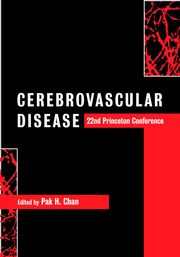Book contents
- Frontmatter
- Contents
- List of contributors
- Preface
- Acknowledgments
- Part I Special lectures
- Part II Oxidative stress
- Part III Apoptosis
- Part IV Hot topics
- Part V Hemorrhage, edema and secondary injury
- Part VI Inflammation
- Part VII Gene transfer and therapy
- Part VIII Neurogenesis and plasticity
- Part IX Magnetic resonance imaging in clinical stroke
- Part X Risk factors, clinical trials and new therapeutic horizons
- 32 Vascular factors in Alzheimer's disease
- 33 Beyond neuroprotection: the protection of axons and oligodendrocytes in cerebral ischemia
- 34 Combining neuroprotection with thrombolysis: how to translate laboratory success to our clinical trials
- 35 Prospects for improved neuroprotection trials in stroke
- 36 Basic research and stroke therapeutics: what have we learned?
- Index
- Plate section
34 - Combining neuroprotection with thrombolysis: how to translate laboratory success to our clinical trials
from Part X - Risk factors, clinical trials and new therapeutic horizons
Published online by Cambridge University Press: 02 November 2009
- Frontmatter
- Contents
- List of contributors
- Preface
- Acknowledgments
- Part I Special lectures
- Part II Oxidative stress
- Part III Apoptosis
- Part IV Hot topics
- Part V Hemorrhage, edema and secondary injury
- Part VI Inflammation
- Part VII Gene transfer and therapy
- Part VIII Neurogenesis and plasticity
- Part IX Magnetic resonance imaging in clinical stroke
- Part X Risk factors, clinical trials and new therapeutic horizons
- 32 Vascular factors in Alzheimer's disease
- 33 Beyond neuroprotection: the protection of axons and oligodendrocytes in cerebral ischemia
- 34 Combining neuroprotection with thrombolysis: how to translate laboratory success to our clinical trials
- 35 Prospects for improved neuroprotection trials in stroke
- 36 Basic research and stroke therapeutics: what have we learned?
- Index
- Plate section
Summary
Introduction
My assignment in this book highlighting the cutting edge in the battle against stroke in the experimental laboratory is to describe how the results of this research might be translated into positive results in a clinical experiment. I want to emphasize that what we need to carry out in the laboratory and at the bedside are both experiments. To date, many such experiments have been positive in the laboratory, but most have been negative at the bedside. What have we learned from these experiences? It is logical to me that at the bedside we need to emulate the conditions under which the laboratory experiment turns out positive; in other words, we need to do the “rat experiment” in humans. Those clinical studies that have adhered to this dictum, such as tests of recombinant tissue plasminogen activator (rtPA) and ancrod given within 3 hours of stroke onset, and of prourokinase given only to patients with documented middle cerebral artery occlusion (MCAO), have been the only positive clinical trials to date.
Figure 34.1 depicts the general design of the rat transient MCAO model that is most often used to test neuroprotective drugs, which are the focus of this chapter. It also depicts the general design of the sort of clinical trial that I postulate must be done to get positive results with such a drug in stroke patients. There are four main areas where clinical trials have departed most from this model.
- Type
- Chapter
- Information
- Cerebrovascular Disease22nd Princeton Conference, pp. 416 - 429Publisher: Cambridge University PressPrint publication year: 2002



